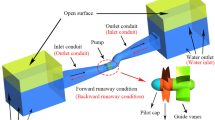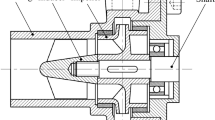Abstract
Reverse flow has a detrimental effect on the stable and safe operation of centrifugal pumps. To study the formation mechanism and suppression of the reverse flow, a semi-open centrifugal pump with circumferential groove in the shroud was simulated. Then, the flow field and pressure fluctuation were analysed. The absolute flow angle at the blade inlet nearing the shroud was close to 180° because of the joint action of the leakage flow and blade inlet impact under low flow rate. This phenomenon resulted in the formation of a low-speed region and the reverse flow and low-frequency pressure fluctuation. The circumferential groove provided a channel for the leakage flow, which could quickly pass through the groove, and reduced the absolute flow angle at the blade inlet nearing the shroud and weakened the trend of the tip leakage flow to upstream. The low-frequency pressure pulsation was eliminated, and the amplitude of the blade passing frequency was reduced under 0.7 Qd (Qd is the design flow rate). The reverse flow thickness coefficient became zero with the circumferential groove. The proportion of the reverse flow volume to the volume of inlet pipe decreased from 14.7 % to 2.2 % under 0.4 Qd. This research indicated that the circumferential groove arranged in the shroud could effectively suppress or eliminate reverse flow.
Similar content being viewed by others
Abbreviations
- CG:
-
Circumferential groove
- C p :
-
Static pressure coefficient
- f n :
-
Shaft frequency
- SW:
-
Smooth wall
- Y :
-
Reverse flow thickness coefficient
- δ 1 :
-
Reverse flow thickness
References
W. X. Ye et al., Instability analysis under part-load conditions in centrifugal pump, Journal of Mechanical Science and Technology, 33 (1) (2019) 269–278.
Y. Li et al., An experimental study on the cavitation vibration characteristics of a centrifugal pump at normal flow rate, Journal of Mechanical Science and Technology, 32 (10) (2018) 4711–4720.
K. Kan et al., Numerical study on the internal flow characteristics of an axial-flow pump under stall conditions, Journal of Mechanical Science and Technology, 32 (10) (2018) 4683–4695.
L. L. Zheng et al., Effects of clearance flow on the characteristics of centrifugal pump under low flow rate, Journal of Mechanical Science and Technology, 34 (1) (2020) 189–200.
J. X. Lu et al., The characteristics investigation under the unsteady cavitation condition in a centrifugal pump, Journal of Mechanical Science and Technology, 31 (3) (2017) 1213–1222.
L. K. Wang et al., Numerical simulation of the tip leakage vortex characteristics in a semi-open centrifugal pump, Applied Sciences, 9 (23) (2019) 5244.
Y. D. Han and L. Tan, Dynamic mode decomposition and reconstruction of tip leakage vortex in a mixed flow pump as turbine at pump mode, Renewable Energy, 155 (2020) 725–734.
X. Q. Jia, B. L. Cui and Y. L. Zhan, Study on internal flow and external performance of a semi-open impeller centrifugal pump with different tip clearances, International Journal of Turbo & Jet-Engines, 32 (1) (2015) 1–12.
Y. B. Liu and L. Tan, Tip clearance on pressure fluctuation intensity and vortex characteristic of a mixed flow pump as turbine at pump mode, Renewable Energy, 129 (2018) 606–615.
J. L. Yang et al., Numerical simulation of internal flow field of an unshrounded centrifugal impeller in a low specific pump, Journal of Engineering Thermophysics, 34 (02) (2013) 262–265.
Y. Choi, J. Kurokawa and J. Matsui, Performance and internal flow characteristics of a very low specific speed centrifugal pump, Journal of Fluids Engineering, 128 (2006) 341–349.
Y. B. Liu and L. Tan, Spatial-temporal evolution of tip leakage vortex in a mixed flow pump with tip clearance, Journal of Fluids Engineering, 141 (8) (2019) 081302.
Y. B. Liu and L. Tan, Theoretical prediction model of tip leakage vortex in a mixed flow pump with tip clearance, Journal of Fluids Engineering, 142 (2020) 021203.
Y. S. Nobuhiro et al., LES simulation of backflow vortex structure at the inlet of an inducer, Journal of Fluids Engineering, 129 (5) (2007) 587–594.
R. S. Zhu and M. X. Ou, Simulation of reverse flow in low specific speed double suction centrifugal pump, Transactions of The Chinese Society of Agricultural Machinery, 40 (4) (2009) 82–85.
Y. Fu, J. Yuan and S. Yuan, Numerical and experimental analysis of flow phenomena in a centrifugal pump operating under low flow rates, Journal of Fluids Engineering, 137 (2015) 011102.
K. Yamamoto and Y. Tsujimoto, Backflow vortex cavitation and its effects on cavitation instabilities, International Journal of Fluid Machinery and Systems, 2 (1) (2009) 40–54.
J. P. Yuan et al., A study on the unsteady characteristics of the backflow vortex cavitation in a centrifugal pump, Journal of Vibration and Shock, 37 (16) (2018) 24–30.
X. Q. Jia et al., Flow characteristics of blade tip clearance in semi-open centrifugal pump in variable condition, Transactions of the Chinese Society of Agricultural Engineering, 31 (4) (2015) 91–96.
D. Juan et al., The impact of casing groove location on stall margin and tip clearance flow in a low-speed axial compressor, Journal of Turbomachinery, 138 (2016) 121007.
L. Liu et al., The stall inceptions in an axial compressor with single circumferential groove casing treatment at different axial locations, Aerospace Science & Technology, 59 (2016) 145–154.
S. L. Saha, J. Kurokawa and J. matsui, Supression of performance curve instability of a mixed flow pump by use of J-groove, Journal of Fluids Engineering, 122 (2000) 592–597.
N. Shimiya, A. Fujii and H. Horiguchi, Suppression of cavitation Instabilities in an inducer by J groove, Journal of Fluids Engineering, 130 (2) (2008) 021302.
J. J. Feng et al., Elimination of hump in axial pump characteristic curve by adopting axial grooves on wall of inlet pipe, Transactions of the Chinese Society of Agricultural Engineering, 34 (13) (2018) 105–112.
H. X. Chen et al., On the hydrodynamics of hydraulic machinery and flow control, Journal of Hydrodynamics, 29 (5) (2017) 782–789.
J. Skrzypacz and M. Bieganowski, The influence of micro grooves on the parameters of the centrifugal pump impeller, International Journal of Mechanical Sciences, 124 (2017) 827–835.
Y. Sakuma et al., Numerical analysis of flow in a transonic compressor with a single circumferential casing groove: influence of groove location and depth on flow instability, Journal of Turbomachinery, 136 (3) (2014) 031017.
W. L. Chu, X. G. Lu and Y. H. Wu, Numerical and experimental investigations of the flow in a compressor with circumferential grooves, Journal of Aerospace Power, 1 (2006) 100–105.
H. X. Chen et al., A computational fluid dynamics study of circumferential groove casing treatment in a transonic axial compressor, Journal of Turbomachinery, 136 (3) (2014) 031003.
V. Mileshin, I. Brailko and A. Startsev, Application of casing circumferential grooves to counteract the influence of tip clearance, ASME Turbo Expo 2008: Power for Land, Sea, and Air (2008) 51147.
S. F. Zhao et al., Investigation for the effects of circumferential grooves on the unsteadiness of tip clearance flow to enhance compressor flow instability, ASME Turbo Expo 2010: Power for Land, Sea, and Air (2010) 269–277.
Y. Hwang and S. H. Kang, Numerical study on the effects of casing treatment on unsteadiness of tip leakage flow in an axial compressor, ASME Turbo Expo: Turbine Technical Conference & Exposition (2012) 68444.
X. C. Mao, B. Liu and H. Zhao, Numerical analysis of the circumferential grooves casing treatment in a counter-rotating axial flow compressor, Applied Thermal Engineering, 130 (2018) 29–39.
M. Rolfes, M. Lange and K. Vogeler, Experimental and numerical investigation of a circumferential groove casing treatment in a low-speed axial research compressor at different tip clearances, Journal of Turbomachinery, 139 (12) (2017) 121009.
X. D. Huang, H. X. Chen and K. Shi, An analysis of the circumferential grooves casing treatment for transonic compressor flow, Science China (Physics, Mechanics & Astronomy), 2 (2010) 166–172.
C. Q. Liu et al., New omega vortex identification method, Science China (Physics, Mechanics & Astronomy), 59 (8) (2016) 1–9.
Y. N. Zhang et al., Comparisons of and analyses of vortex identification between omega method and Q criterion, Journal of Hydrodynamics, 31 (2) (2019) 1–7.
K. Yamada, K. Funazaki and M. Furukawa, The behavior of tip clearance flow at near-stall condition in a transonic axial compressor rotor, ASME Turbo Expo (2007) 27725.
W. Wang et al., Numerical Investigation on the effects of circumferential coverage of injection in a transonic compressor with discrete tip injection, ASME Turbo Expo (2014) 25420.
Acknowledgments
This work was supported by the National Natural Science Foundation of China (Grant No. 51879216, 51679196 and 51679195).
Author information
Authors and Affiliations
Corresponding author
Additional information
Jinling Lu received his Ph.D. degree from Xi’an Jiaotong University, China, in 2005. He is currently a Professor in Xi’an University of Technology. His main scientific interests are optimization and design of hydraulic machinery, CFD simulations and flow measurements by PIV.
Rights and permissions
About this article
Cite this article
Wang, L., Lu, J., Liao, W. et al. Numerical analysis of the formation mechanism and suppression method of the reverse flow in a semi-open centrifugal pump. J Mech Sci Technol 34, 3667–3678 (2020). https://doi.org/10.1007/s12206-020-0819-7
Received:
Revised:
Accepted:
Published:
Issue Date:
DOI: https://doi.org/10.1007/s12206-020-0819-7




